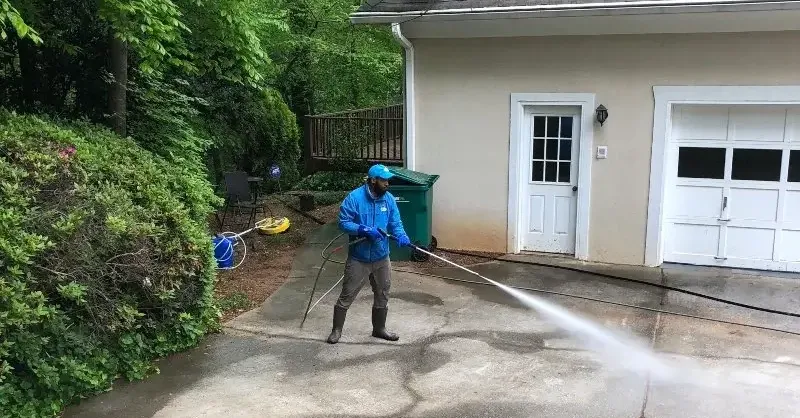Two popular methods often come into play when cleaning outdoor surfaces: pressure washing and power washing. Both techniques employ high-pressure water to clean surfaces effectively. Still, they have distinct differences that can impact their suitability for various tasks. In this article, we’ll delve into pressure and power washing, exploring their definitions, equipment, applications, safety considerations, and costs and helping you determine the right choice for your cleaning needs.
Definitions and Key Differences
Pressure Washing: Pressure washing is a cleaning technique that uses water under high pressure to remove dirt, grime, dust, and loose materials from surfaces. It is a versatile method known for effectively cleaning various outdoor surfaces. However, pressure washing does not use heated water in the process.
Power Washing: Power washing is similar to pressure washing but with one significant difference: it incorporates the use of heated water. Adding heat enhances the cleaning power, making it highly effective in removing grease, oil, and stubborn stains. Power washing is suitable for both outdoor and some indoor cleaning tasks.
Equipment and Components
Pressure Washing Equipment:
- Pressure washer unit: The heart of the pressure washing system generates high-pressure water.
- Water source and supply: A water source, like a hose or water tank, is required to provide a steady supply.
- Nozzle and spray tips: These components determine the pressure and spray pattern.
- Detergents and chemicals: Optional additives to enhance cleaning effectiveness.
Power Washing Equipment:
- Pressure washer unit: Similar to pressure washing but often with a heating element or boiler.
- Heating element or boiler: Heats the water before it’s expelled from the nozzle.
- Water source and supply: A steady water source, like pressure washing, is needed.
- Nozzle and spray tips: Similar to pressure washing, these determine pressure and pattern.
- Detergents and chemicals: Can be used in conjunction with the heated water for even better results.
Cleaning Efficiency
Pressure Washing: Pressure washing removes dirt, dust, and loose materials from surfaces. It’s suitable for cleaning decks, patios, sidewalks, driveways, exterior walls, fences, and even vehicles. However, its effectiveness may be limited regarding stubborn stains and mold.
Power Washing: Power washing takes cleaning efficiency to the next level. Adding heated water makes it highly effective in removing grease, oil, and tough stains that may resist pressure washing. It’s suitable for various applications, including commercial kitchens, industrial machinery, oil stain removal from concrete, and graffiti removal.
Applications
Pressure Washing Applications:
- Decks and patios: Pressure washing can revitalize these outdoor areas by removing dirt, mildew, and stains.
- Sidewalks and driveways: It efficiently cleans concrete surfaces, removing accumulated grime and dirt.
- Exterior walls and fences: Pressure washing restores the shine to your home’s exterior and wooden fences.
- Vehicles: Pressure washing is a quick way to clean cars, trucks, boats, and other vehicles.
Power Washing Applications:
- Commercial kitchens and restaurants: Power washing is ideal for cleaning commercial kitchens, removing grease, and ensuring hygiene.
- Industrial machinery and equipment: The combination of high pressure and heat helps remove stubborn residues from machinery.
- Removing oil stains from concrete surfaces: Power washing can effectively eliminate oil stains from driveways and garage floors.
- Graffiti removal: Heated water makes removing graffiti from various surfaces easier.
Safety Considerations
Pressure Washing Safety:
- High-pressure water risk: Users must exercise caution to avoid injury from the powerful water jet.
- Appropriate protective gear: Safety goggles, gloves, and appropriate clothing are necessary.
- Environmental impact of detergents: Care must be taken to use eco-friendly detergents to minimize environmental harm.
Power Washing Safety:
- High-pressure and hot water risk: Users should be even more cautious due to the addition of heat.
- Proper training and equipment handling: Adequate training is essential for safe power washing.
- Environmental concerns with heated water runoff: Heated water runoff can damage plants and animals, so care should be taken when disposing of it.
Cost and Accessibility
Pressure Washing Costs: Pressure washing equipment is generally more affordable and accessible for homeowners. The absence of a heating element reduces the initial investment and operating costs.
Power Washing Costs: Power washing equipment, with its heating element or boiler, is typically more expensive than pressure washing equipment. The cost of heating water also increases operational expenses.
Conclusion
In conclusion, pressure and power washing are adequate cleaning methods that utilize high-pressure water to clean surfaces. Pressure washing is versatile and suitable for most outdoor cleaning tasks. In contrast, power washing, with its heated water, is more effective at removing tough stains, grease, and oil. Choosing the right method depends on your cleaning needs, budget, and safety considerations.
Thanks to Jaden’s Pressure Washing for help with this article.






